The Corrosion Behavior of X100 Pipeline Steel in a Sodium Chloride Solution Containing Magnesium and Calcium
Abstract
:1. Introduction
2. Experimental
2.1. Materials and Electrolytes
2.2. Electrochemical and Surface Analysis Measurements
3. Results and Discussion
3.1. Effects of Mg2+ and Ca2+ on the Short-Term Corrosion Behavior of X100
3.2. Effects of Mg2+ and Ca2+ on the Compositions of Corrosion Scale
3.3. Effects of Mg2+ and Ca2+ on the Longer-Term Corrosion Behavior of X100
4. Conclusions
- The corrosion of X100 pipeline steel (icorr 262.4 μA cm−2) after 1800 s of exposure was inhibited by the presence of either Ca2+ (icorr 163.5 μA cm−2) or Mg2+ (icorr 80.8 μA cm−2) in the NaCl solution saturated with CO2.
- Either Mg2+ or Ca2+ in the NaCl solution saturated with CO2 can affect the scale structures by forming carbonate species. Though Mg2+ addition can trigger a decrease in the formation rate of the corrosion scale, the sample with Mg2+ addition still shows a decrease in the corrosion rate due to the inhibition effect of Mg2+ in the electrolyte.
- The Ca2+ in the solution accelerates the formation of the protective scale in the NaCl solution saturated with CO2, thus improving the corrosion resistance of carbon steel.
Supplementary Materials
Author Contributions
Funding
Institutional Review Board Statement
Informed Consent Statement
Data Availability Statement
Conflicts of Interest
References
- Conti, J.J.; Holtberg, P.D.; Beamon, J.; Schaal, A.M.; Ayoub, J.; Turnure, J.T. Annual Energy Outlook 2014; US Energy Information Administration: Washington, DC, USA, 2012.
- Romualdi, N.; Militzer, M.; Poole, W.; Collins, L.; Lazor, R. Austenite Grain Size Model for the Coarse Grain Heat Affected Zone in Line Pipe Steels. In Proceedings of the International Pipeline Conference, Virtual, 28–30 September 2020. [Google Scholar]
- Majchrowicz, K.; Brynk, T.; Wieczorek, M.; Miedzińska, D.; Pakieła, Z. Exploring the susceptibility of P110 pipeline steel to stress corrosion cracking in CO2-rich environments. Eng. Fail. Anal. 2019, 104, 471–479. [Google Scholar] [CrossRef]
- Nyborg, R. Overview of CO2 corrosion models for wells and pipelines. In Corrosion 2002; NACE International: Houston, TX, USA, 2002. [Google Scholar]
- Ingham, B.; Laycock, N.J.; Burnell, M.K.; Kappen, P.; Kimpton, J.; Williams, D. In situ synchrotron X-ray diffraction study of scale formation during CO2 corrosion of carbon steel in sodium and magnesium chloride solutions. Corros. Sci. 2012, 56, 96–104. [Google Scholar] [CrossRef]
- Wang, S.; Lamborn, L.; Chevil, K.; Gamboa, E.; Chen, W. Near-neutral pH corrosion of mill-scaled X-65 pipeline steel with paint primer. J. Mater. Sci. Technol. 2020, 49, 166–178. [Google Scholar] [CrossRef]
- Esmaeely, S.N.; Choi, Y.S.; Young, D.; Nešic, S. Effect of calcium on the formation and protectiveness of iron carbonate layer in CO2 corrosion. Corrosion 2013, 69, 912–920. [Google Scholar] [CrossRef] [Green Version]
- Esmaeely, S.N.; Young, D.; Brown, B.; Nešic, S. Effect of incorporation of calcium into iron carbonate protective layers in CO2 corrosion of mild steel. Corrosion 2016, 73, 238–246. [Google Scholar] [CrossRef] [Green Version]
- Zhu, J.; Ren, H.; Xu, L. Corrosion behavior and in-situ pH monitoring of a 3% chromium low alloy pipeline steel welded joint in a CO2 environment. Mater. Res. Express. 2019, 6, 116573. [Google Scholar] [CrossRef]
- Zeng, D.; Dong, B.; Zhang, S. Annular corrosion risk analysis of gas injection in CO2 flooding and development of oil-based annulus protection fluid. J. Pet. Sci. Eng. 2022, 208, 109526. [Google Scholar] [CrossRef]
- Jiang, X.; Zheng, Y.; Qu, D.; Ke, W. Effect of calcium ions on pitting corrosion and inhibition performance in CO2 corrosion of N80 steel. Corros. Sci. 2006, 48, 3091–3108. [Google Scholar] [CrossRef]
- Pots, B.F. Prediction of corrosion rates of the main corrosion mechanisms in upstream applications. In Corrosion 2005; NACE International: Houston, TX, USA, 2005. [Google Scholar]
- Chen, T.; Neville, A.; Yuan, M. Influence of Mg2+ on the Kinetics and Crystal Morphology of CaCO3 Scale Formation on the Metal Surface and in Bulk Solution. In Corrosion 2004; NACE International: Houston, TX, USA, 2004. [Google Scholar]
- Olivo, J.M.D.; Brown, B.; Young, D. Electrochemical Model of CO2 Corrosion in the Presence of Quaternary Ammonium Corrosion Inhibitor Model Compounds. In Proceedings of the Corrosion Conference and Expo, Nashville, TN, USA, 24–28 March 2019. [Google Scholar]
- Xiang, Y.; Xu, M.; Choi, Y.-S. State-of-the-art overview of pipeline steel corrosion in impure dense CO2 for CCS transportation: Mechanisms and models. Corros. Eng. Sci. Technol. 2017, 52, 485–509. [Google Scholar] [CrossRef]
- Ulaganathan, J.; Ha, H. Investigation on the Effect of Lead (Pb) on the Degradation Behavior of Passive Films on Alloy 800. In Proceedings of the International Conference on Environmental Degradation of Materials in Nuclear Power Systems-Water Reactors, Boston, MA, USA, 18–22 August 2019. [Google Scholar]
- Nordsveen, M.; Nešic, S.; Nyborg, R.; Stangeland, A. A mechanistic model for carbon dioxide corrosion of mild steel in the presence of protective iron carbonate films—Part 1: Theory and verification. Corrosion 2003, 59, 443–456. [Google Scholar] [CrossRef] [Green Version]
- Collazo, A.; Nóvoa, X.; Pérez, C. The role of Mg2+ ions in the corrosion behaviour of AA2024-T3 aluminium alloys immersed in chloride-containing environments. Electrochim. Acta 2014, 124, 17–26. [Google Scholar] [CrossRef]
- Golabadi, M.; Foratirad, H.; Asgari, M.; Gholami, M.G.; Karimi, M. The synergistic effect of 2-mercaptobenzotiazole and zinc nitrate as corrosion inhibitor on carbon steel in saline solution. Int. J. Mater. Res. 2020, 10, 111. [Google Scholar]
- Berntsen, T.; Seiersten, M.; Hemmingsen, T. Effect of FeCO3 supersaturation and carbide exposure on the CO2 corrosion rate of carbon steel. Corrosion 2013, 69, 601–613. [Google Scholar] [CrossRef] [Green Version]
- Graf, D. Crystallographic tables for the rhombohedral carbonates. Am. Mineral. 1961, 46, 1283–1316. [Google Scholar]
- Wei, L.; Pang, X.; Liu, C.; Gao, K. Formation mechanism and protective property of corrosion product scale on X70 steel under supercritical CO2 environment. Corros. Sci. 2015, 100, 404–420. [Google Scholar] [CrossRef]
- Zaitsev, A.I.; Rodionova, I.G.; Arutyunyan, N.A.; Dunaev, S.F. Study of Effect of Non-Metallic Inclusions on Structural State and Properties of Low-Carbon Microalloyed Structural Steels. Metallurgist 2021, 64, 10. [Google Scholar] [CrossRef]
- Wang, L.; Shinohara, T.; Zhang, B.-P. XPS study of the surface chemistry on AZ31 and AZ91 magnesium alloys in dilute NaCl solution. Appl. Surf. Sci. 2010, 256, 5807–5812. [Google Scholar] [CrossRef]
- Ni, M.; Ratner, B.D. Differentiating calcium carbonate polymorphs by surface analysis techniques—An XPS and TOF-SIMS study. Surf. Interface Anal. 2008, 40, 1356–1361. [Google Scholar] [CrossRef] [Green Version]
- Wu, S.L.; Cui, Z.D.; He, F.; Bai, Z.Q.; Zhu, S.L.; Yang, X.J. Characterization of the surface film formed from carbon dioxide corrosion on N80 steel. Mater. Lett. 2004, 58, 1076–1081. [Google Scholar] [CrossRef]
- Ye, F.; Jiao, Z.; Yan, S.; Guo, L.; Feng, L.; Yu, J. Microbeam plasma arc remanufacturing: Effects of Al on microstructure, wear resistance, corrosion resistance and high temperature oxidation resistance of AlxCoCrFeMnNi high-entropy alloy cladding layer. Vacuum 2020, 174, 1. [Google Scholar] [CrossRef]
- Gao, M.; Pang, X.; Gao, K. The growth mechanism of CO2 corrosion product films. Corros. Sci. 2011, 53, 557–568. [Google Scholar] [CrossRef]
- Gadala, I.M.; Alfantazi, A. A study of X100 pipeline steel passivation in mildly alkaline bicarbonate solutions using electrochemical impedance spectroscopy under potentiodynamic conditions and Mott–Schottky. Appl. Surf. Sci. 2015, 357, 356–368. [Google Scholar] [CrossRef]
- Farelas, F.; Galicia, M.; Brown, B.; Nesic, S.; Castaneda, H. Evolution of dissolution processes at the interface of carbon steel corroding in a CO2 environment studied by EIS. Corros. Sci. 2010, 52, 509–517. [Google Scholar] [CrossRef]
- Sridhar, N.; Dunn, D.; Anderko, A.; Lencka, M.; Schutt, H. Effects of water and gas compositions on the internal corrosion of gas pipelines-modeling and experimental studies. Corrosion 2001, 57, 221–235. [Google Scholar] [CrossRef]
- De Alwis, C.; Trought, M.; Lundeen, J.; Perrine, K.A. Effect of Cations on the Oxidation and Atmospheric Corrosion of Iron Interfaces to Minerals. J. Phys. Chem. A 2021, 36, 125. [Google Scholar] [CrossRef] [PubMed]
- Tanupabrungsun, T.; Brown, B.; Nesic, S. Effect of pH on CO2 corrosion of mild steel at elevated temperatures. In Corrosion/2013 Paper; NACE International: Houston, TX, USA, 2013. [Google Scholar]
- Hussien, B.M.; Al-Sabagh, A.M.; Migahed, M.A. Corrosion Control of X-60 Type Carbon Steel in Petroleum Formation Water Under High Pressure of CO2 at High Temperature. In Proceedings of the Offshore Mediterranean Conference and Exhibition, Ravenna, Italy, 29–31 March 2017. [Google Scholar]
- Liu, Z.; Gao, X.; Du, L.; Li, J.; Zheng, C.; Wang, X. Corrosion mechanism of low-alloy steel used for flexible pipe in vapor-saturated H2S/CO2 and H2S/CO2-saturated brine conditions. Mater. Corros. 2018, 69, 9. [Google Scholar] [CrossRef]
- Liu, Q.; Mao, L.; Zhou, S. Effects of chloride content on CO2 corrosion of carbon steel in simulated oil and gas well environments. Corros. Sci. 2014, 84, 165–171. [Google Scholar] [CrossRef]
- Van Hunnik, E.; Pots, B.F.; Hendriksen, E. The Formation of Protective FeCO3 Corrosion Product Layers in CO2 Corrosion; NACE International: Houston, TX, USA, 1996. [Google Scholar]
- Wei, L.; Pang, X.; Zhou, M.; Gao, K. Effect of exposure angle on the corrosion behavior of X70 steel under supercritical CO2 and gaseous CO2 environments. Corros. Sci. 2017, 121, 57–71. [Google Scholar] [CrossRef]
- López, D.A.; Simison, S.N.; de Sánchez, S.R. The influence of steel microstructure on CO2 corrosion. EIS studies on the inhibition efficiency of benzimidazole. Electrochim. Acta 2003, 48, 845–854. [Google Scholar] [CrossRef]
- Liu, J.; Alfantazi, A.; Asselin, E. A new method to improve the corrosion resistance of titanium for hydrometallurgical applications. Appl. Surf. Sci. 2015, 332, 480–487. [Google Scholar] [CrossRef]
- Sun, J.B.; Zhang, G.A.; Liu, W.; Lu, M.X. The formation mechanism of corrosion scale and electrochemical characteristic of low alloy steel in carbon dioxide-saturated solution. Corros. Sci. 2012, 57, 131–138. [Google Scholar] [CrossRef]
- Eliyan, F.F.; Alfantazi, A. On the theory of CO2 corrosion reactions–Investigating their interrelation with the corrosion products and API-X100 steel microstructure. Corros. Sci. 2014, 85, 380–393. [Google Scholar] [CrossRef]
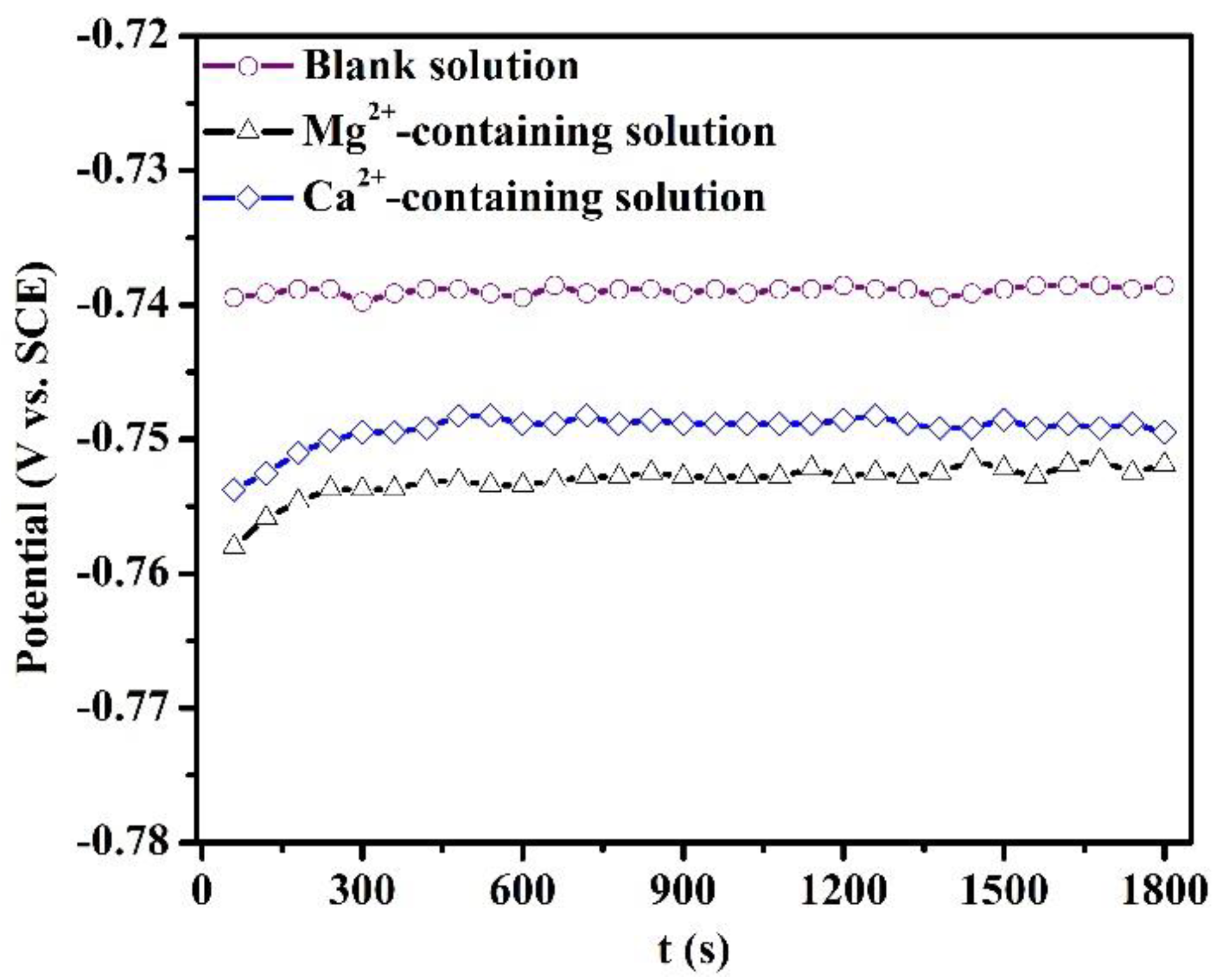
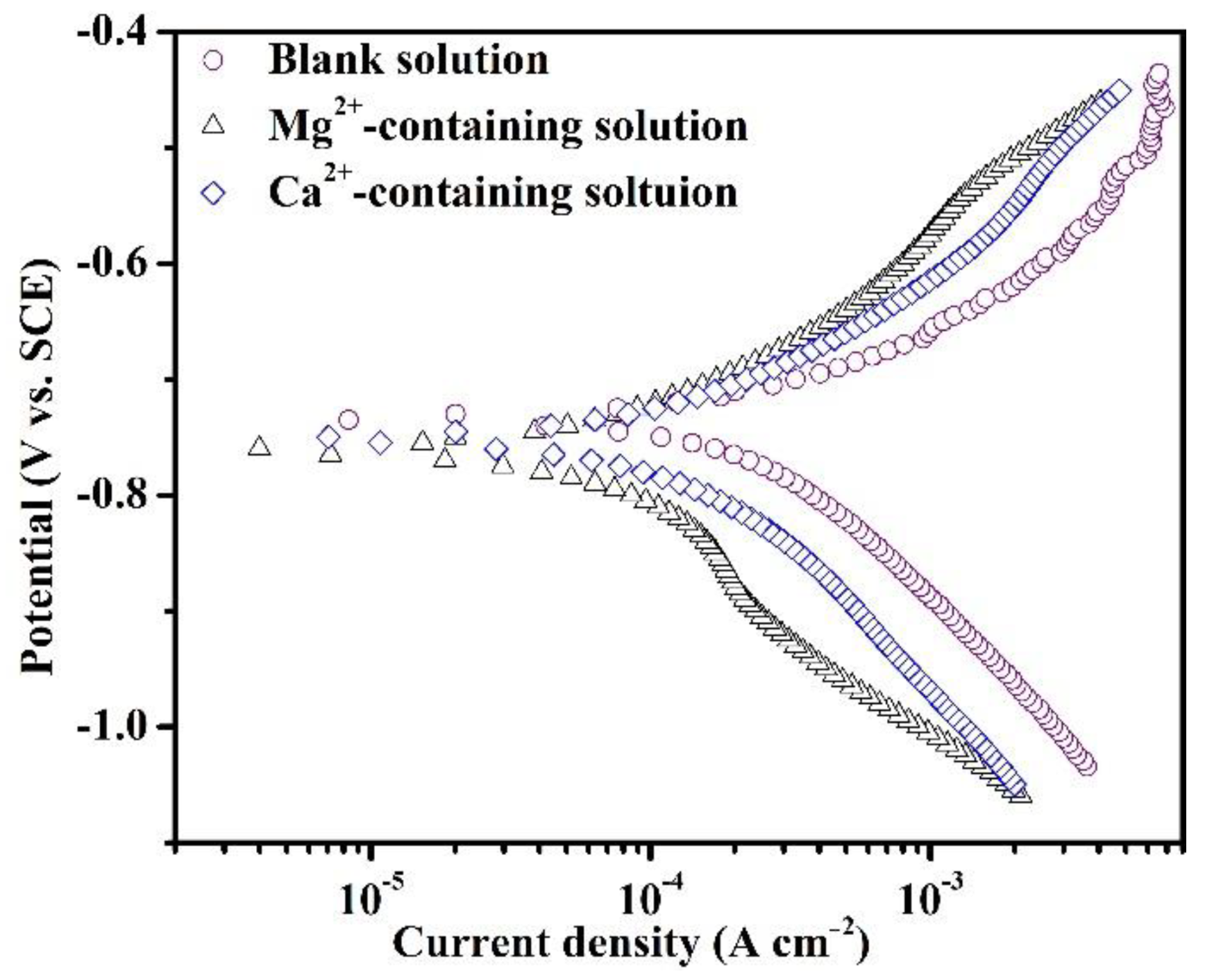
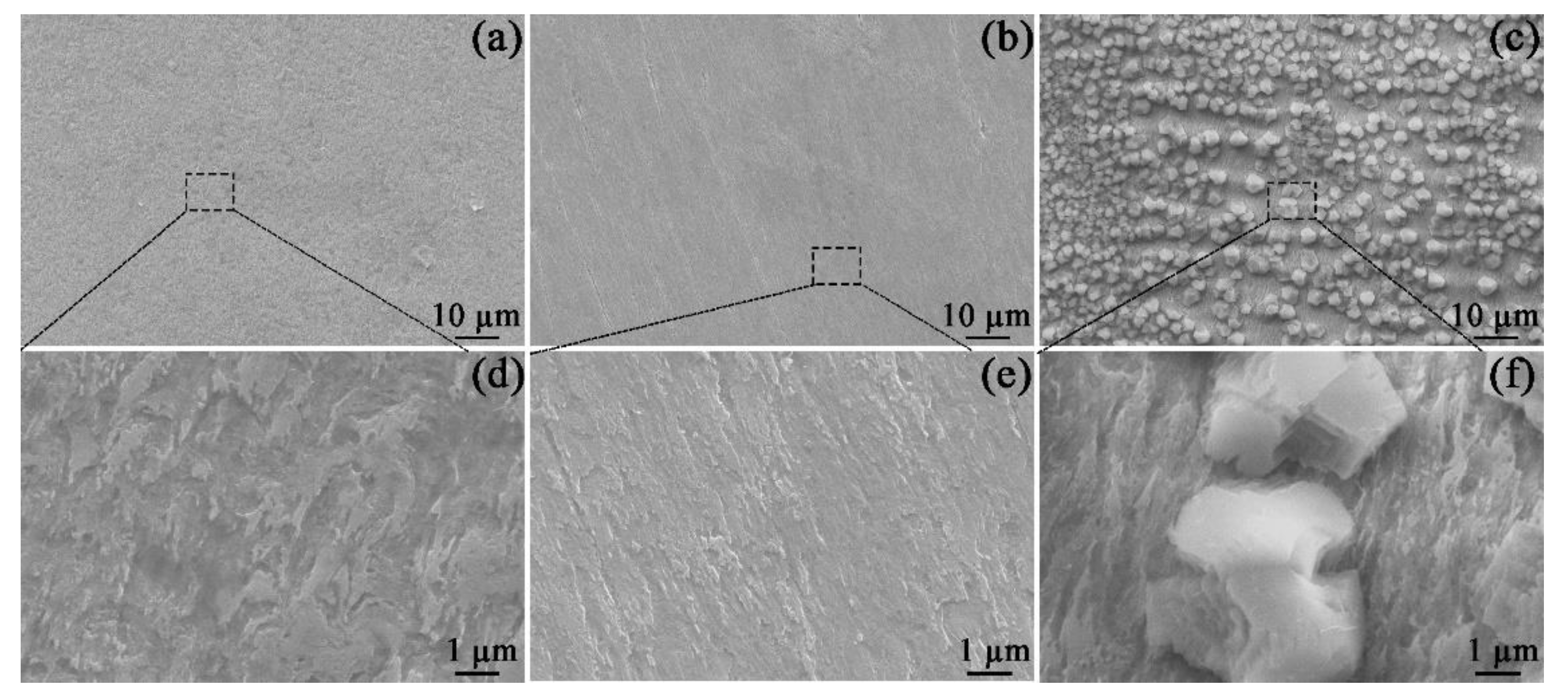


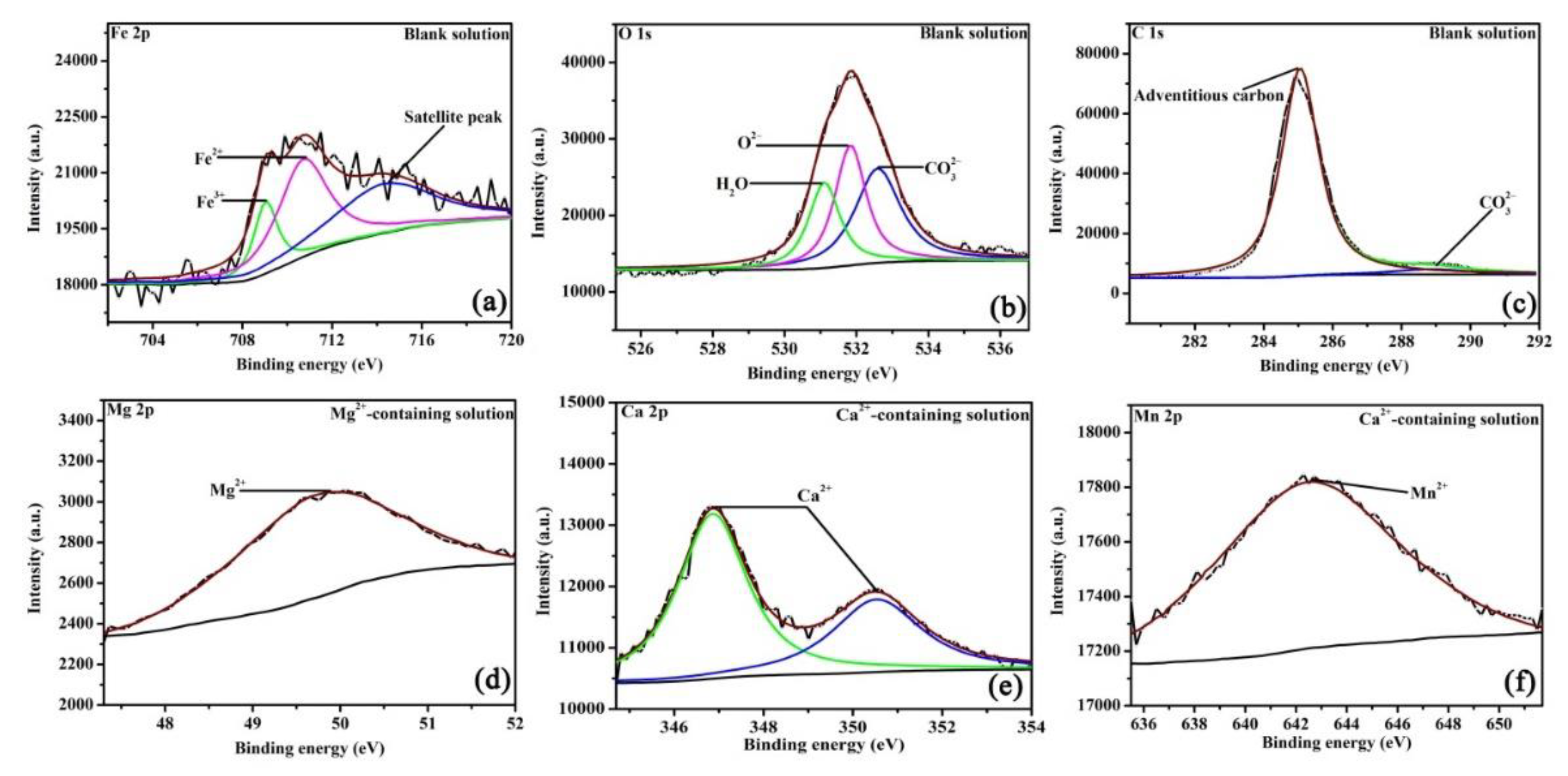
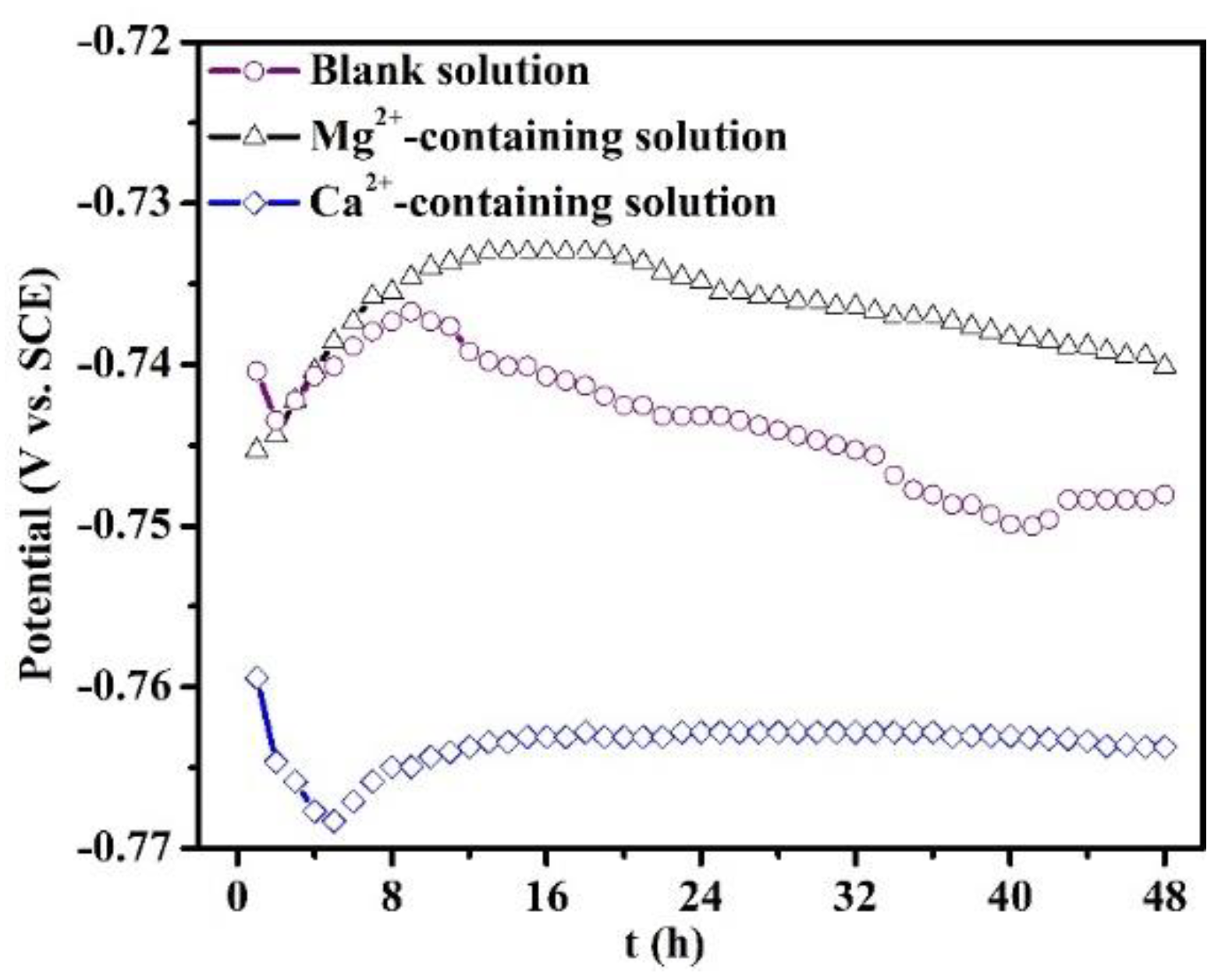

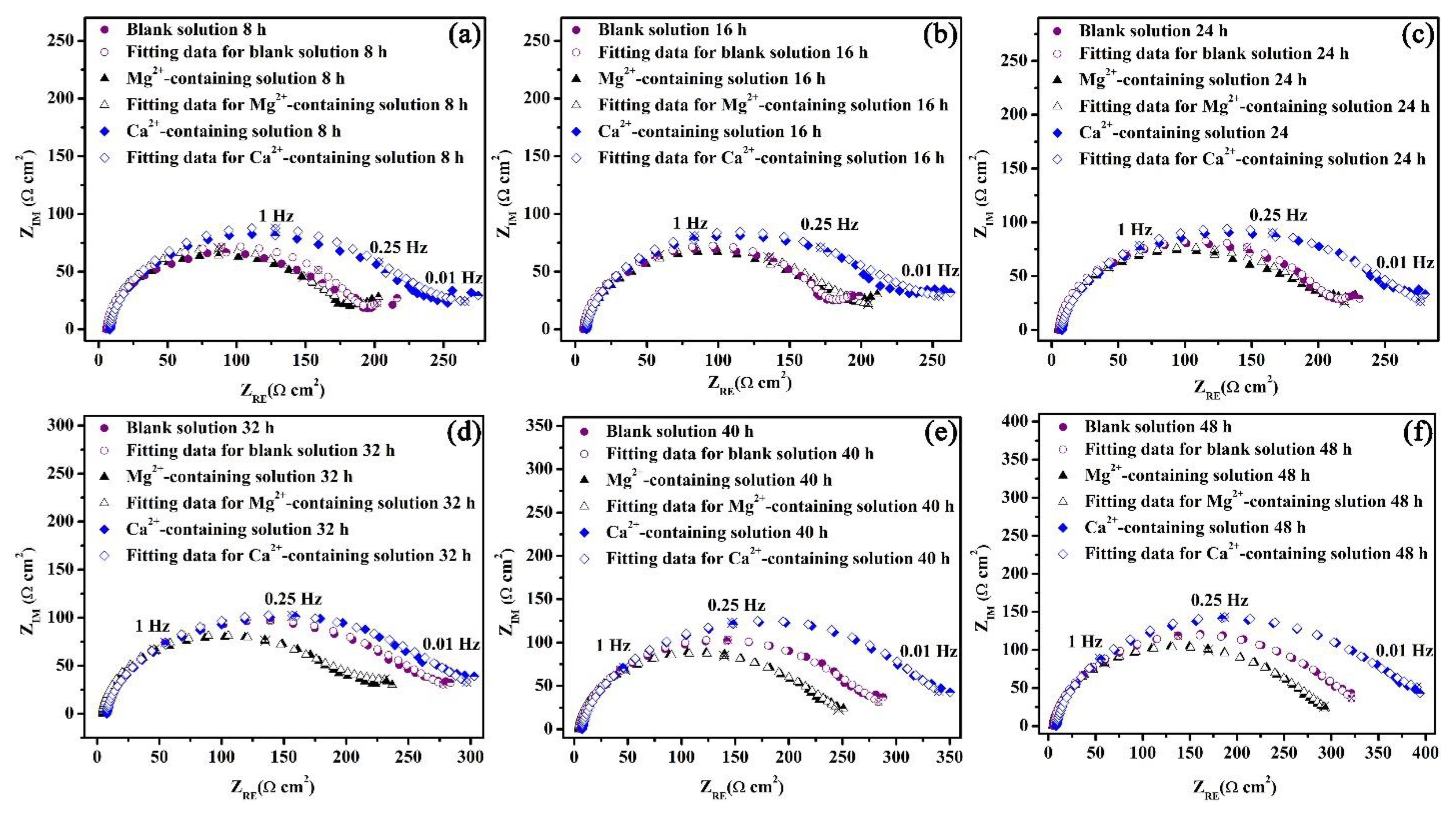

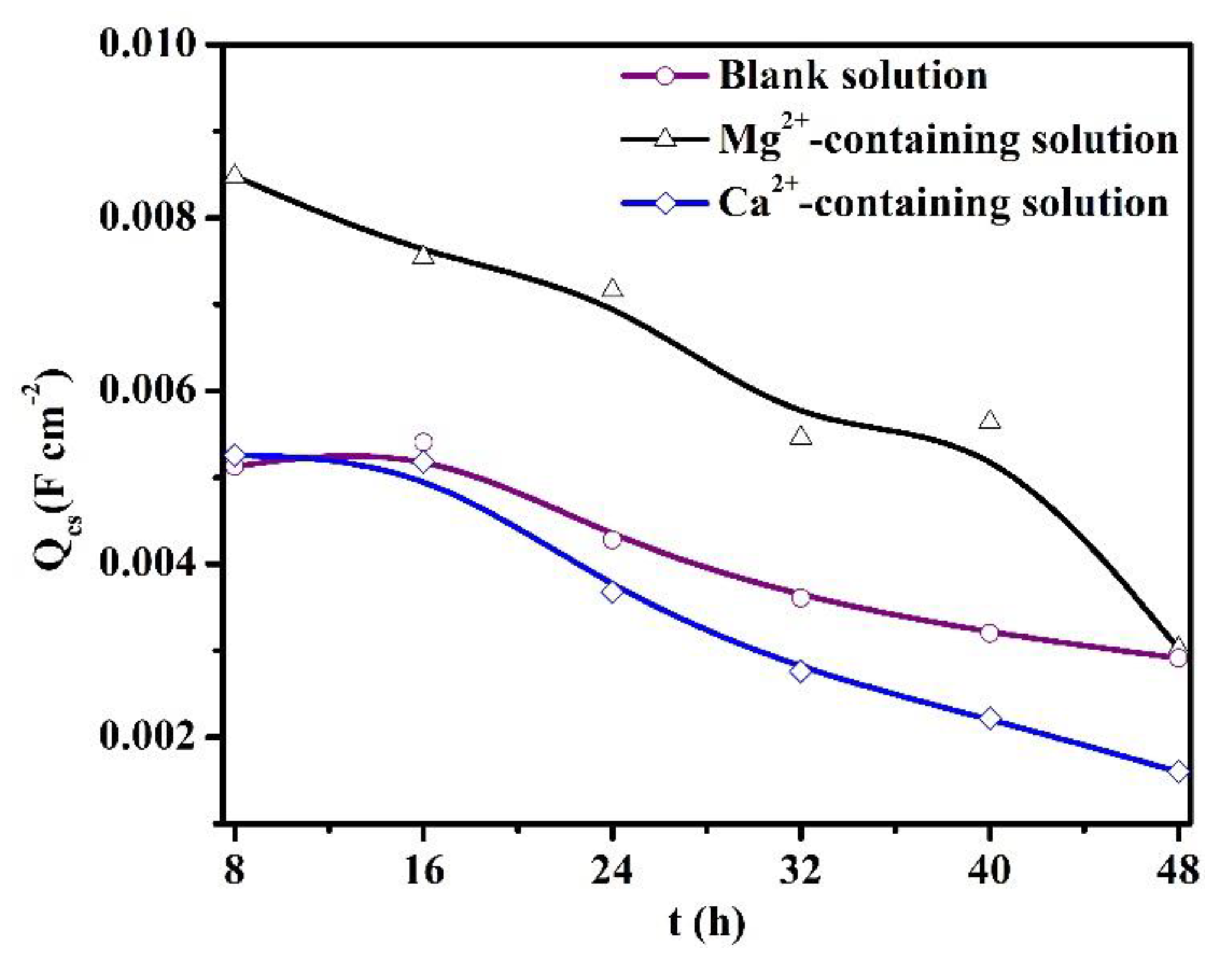

| Element | C | Mo | Al | Mn | Cu | Ni | Ti | Cr | V | Nb |
|---|---|---|---|---|---|---|---|---|---|---|
| X100 (wt.%) | 0.098 | 0.20 | 0.021 | 1.665 | 0.25 | 0.132 | 0.02 | 0.017 | 0.003 | 0.044 |
| Composition | NaCl (g L−1) | CaCl2 (g L−1) | MgCl2 (g L−1) | Total Cl− (g L−1) |
|---|---|---|---|---|
| Blank solution | 0.7 | 0 | 0 | 0.425 |
| Mg2+-containing solution | 0.456 | 0 | 0.2 | 0.425 |
| Ca2+-containing solution | 0.290 | 0.389 | 0 | 0.425 |
| Solution | Ecorr (mV vs. SCE) | icorr (μA cm−2) | bc (mV dec−1) | ba (mV dec−1) |
|---|---|---|---|---|
| Blank solution | −733.7 | 262.4 | 254 | 155 |
| Mg2+-containing solution | −756.7 | 80.8 | 187 | 198 |
| Ca2+-containing solution | −751.3 | 163.5 | 276 | 179 |
Disclaimer/Publisher’s Note: The statements, opinions and data contained in all publications are solely those of the individual author(s) and contributor(s) and not of MDPI and/or the editor(s). MDPI and/or the editor(s) disclaim responsibility for any injury to people or property resulting from any ideas, methods, instructions or products referred to in the content. |
© 2023 by the authors. Licensee MDPI, Basel, Switzerland. This article is an open access article distributed under the terms and conditions of the Creative Commons Attribution (CC BY) license (https://creativecommons.org/licenses/by/4.0/).
Share and Cite
Yang, X.; Hao, T.; Sun, Q.; Zhang, Z.; Lin, Y. The Corrosion Behavior of X100 Pipeline Steel in a Sodium Chloride Solution Containing Magnesium and Calcium. Materials 2023, 16, 5258. https://doi.org/10.3390/ma16155258
Yang X, Hao T, Sun Q, Zhang Z, Lin Y. The Corrosion Behavior of X100 Pipeline Steel in a Sodium Chloride Solution Containing Magnesium and Calcium. Materials. 2023; 16(15):5258. https://doi.org/10.3390/ma16155258
Chicago/Turabian StyleYang, Xiaoning, Tiancong Hao, Qingya Sun, Zhongwei Zhang, and Yuan Lin. 2023. "The Corrosion Behavior of X100 Pipeline Steel in a Sodium Chloride Solution Containing Magnesium and Calcium" Materials 16, no. 15: 5258. https://doi.org/10.3390/ma16155258
APA StyleYang, X., Hao, T., Sun, Q., Zhang, Z., & Lin, Y. (2023). The Corrosion Behavior of X100 Pipeline Steel in a Sodium Chloride Solution Containing Magnesium and Calcium. Materials, 16(15), 5258. https://doi.org/10.3390/ma16155258






